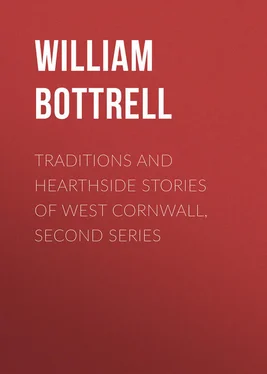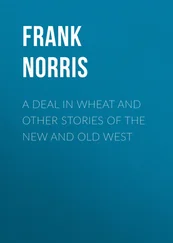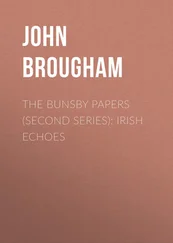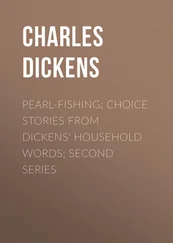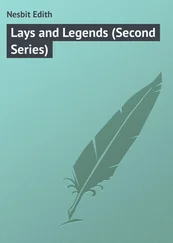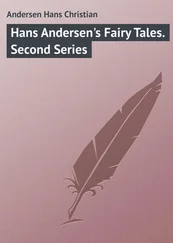William Bottrell - Traditions and Hearthside Stories of West Cornwall, Second Series
Здесь есть возможность читать онлайн «William Bottrell - Traditions and Hearthside Stories of West Cornwall, Second Series» — ознакомительный отрывок электронной книги совершенно бесплатно, а после прочтения отрывка купить полную версию. В некоторых случаях можно слушать аудио, скачать через торрент в формате fb2 и присутствует краткое содержание. Жанр: foreign_antique, foreign_prose, на английском языке. Описание произведения, (предисловие) а так же отзывы посетителей доступны на портале библиотеки ЛибКат.
- Название:Traditions and Hearthside Stories of West Cornwall, Second Series
- Автор:
- Жанр:
- Год:неизвестен
- ISBN:нет данных
- Рейтинг книги:4 / 5. Голосов: 1
-
Избранное:Добавить в избранное
- Отзывы:
-
Ваша оценка:
- 80
- 1
- 2
- 3
- 4
- 5
Traditions and Hearthside Stories of West Cornwall, Second Series: краткое содержание, описание и аннотация
Предлагаем к чтению аннотацию, описание, краткое содержание или предисловие (зависит от того, что написал сам автор книги «Traditions and Hearthside Stories of West Cornwall, Second Series»). Если вы не нашли необходимую информацию о книге — напишите в комментариях, мы постараемся отыскать её.
Traditions and Hearthside Stories of West Cornwall, Second Series — читать онлайн ознакомительный отрывок
Ниже представлен текст книги, разбитый по страницам. Система сохранения места последней прочитанной страницы, позволяет с удобством читать онлайн бесплатно книгу «Traditions and Hearthside Stories of West Cornwall, Second Series», без необходимости каждый раз заново искать на чём Вы остановились. Поставьте закладку, и сможете в любой момент перейти на страницу, на которой закончили чтение.
Интервал:
Закладка:
Another common name for the Celtic circles is the Nine Maidens. Now, as the usual number of stones in the circle is nineteen, that number may have something to do with the first part of this name, and the latter would come from the Cornish, as before, mêdn.
The Daunce-Mêyn is the best known of all the Druidic circles in the west, as it is within sight from the road frequently taken by those visitors to the Logan Rock who care for seeing the many interesting objects, and fine sea views, visible from the lower road, as we call this route near the sea shore. Yet the circle at Boscawen-un, in the higher side of the parish, is invested with a peculiar interest, from the fact of the opinion held by Dr. Borlase that these circles were places of council of judgment, has been confirmed by an old Welsh triad, which makes this place still more remarkable by naming it as one of the three Gorsedds, or places of judgment for poetry and bardic minstrelsy. This valuable relict of Welsh poetry, as translated by the eminent Welsh scholar, the late Rev. Thomas Price, is in English: – "The three Gorsedds of Peetry of the Island of Britain; the Gorsedd of Boscawen Damnonium; (Damnonium included Cornwall and great part of Devon;) the Gorsedd of Salisbury, in England; and the Gorsedd of Bryn Gwyddon in Wales."
We hope that when the laureate revisits Cornwall he may be induced to go there, and, sitting on a granite throne, by the side of the tall central stone, sing the "Idyls of the King," if only in honour of the Welsh bard who has preserved the remembrance of this remarkable temple where ancient minstrels sung of how Merlin, the enchanter, deceived the beautiful Igerna, so that she received King Uter Pendragon as her husband – how King Uter died, and Arthur, his son, by Igerna, kept his court at "Wild Dundagel, by the Cornish sea" – and how our own Prince Arthur, and his knights of the table rounde, slew all the enemies of Britain. Here they sang of the beauty and guile of the fair and frail Guenever – of the honour and truth of Arthur's knights, and the treachery of Mordred. Here the Bard sounded a lament for the lost lands of Lethowsow, and the submerged City of Langona: —
"Between Land's End and Scilly rocks
Sunk lies a town that ocean mocks.
Where breathes the man that would not weep
O'er such fine climes beneath the deep?"
We owe a debt of gratitude to Dr. Borlase for preserving to us a graphic description of these, and many other, Druidic circles which have disappeared since his time.
Fortunately, the work of destruction has been arrested at Boscawen-un circle, as the lady to whom the property belongs has caused it to be surrounded with a good hedge to prevent further spoilation. Some years ago a wholesome fear prevailed of bad luck following anyone who removed these landmarks of a long past age, but now our country folk think themselves more enlightened, and, unless those who have some respect for the monuments of ancient times, take measures to prevent the recipients of this questionable sort of enlightenment from exercising their vandalism, our Celtic remains will soon disappear. Pages might be filled with an account of the destruction which has taken place within the past half century.
That these circles were used for religious, judicical, or political purposes, (and in ancient times all three were combined), there can be no doubt, from the veneration with which they were formerly regarded. This solemn respect was expressed in the belief that the avenging deity, in the shape of Bad Luck (which was felt to be as real a personage as any other undefined invisible demon) would sooner or later overtake the sacrilegious destroyer of the ancient holy stones. In many of the oldest villages there were formerly altar-like stones, known by the name of garrac zans, (the holy stones) which were protected by the fear of the goddess of Bad Luck; and until within these last few years, no rude hand would dare to remove or spoil them. We remember one of these venerated rocks in the village of Rosekestal and another in Sowah town-place. The noted stone in Mayon was also called indifferently the garrac zans or table men. We have heard of many others which were formerly to be seen in the town-places of ancient hamlets, but their places know them no more.
Dr. Borlase describes many circles and other Celtic remains as being in his time almost as perfect as when left by our forefathers thousands of years ago. Of these public monuments, there is now scarcely a trace to be found. Recent investigation proves the trustworthiness of the information preserved by the antiquary, born and bred in Pendeen, in the very heart of a district which contains, even now, more Celtic remains of all kinds than any other portion, of equal space, in the British Isles.
By similar monuments to those we have noticed at Boleigh, the migrations of the ancient Celtic race may be traced from farthest Ind to the Scilly Isles.
The last Cardew, of Boskenna, and theStory of Nelly Wearne
No ditch is so deep, no wall is so high,
If two love each other, they'll meet by and bye;
No storm is so wild, and no night is so black,
If two wish to meet they will soon find a track.
THERE are few places which afford such a variety of picturesque views as may be seen in and from the grounds of Boskenna ("dwelling-on-the-ridge.") The sylvan and rural are beheld, forming endless combinations with the grand, the wild, and the romantic. Glimpses of the boundless ocean are caught through overarching boughs in deep winding glens, where the brilliant plants of semi-tropical climes are seen growing in loving companionship with our more modest and sweet native shrubs, ferns, and flowers.
From the height called the Rockery, (surely there must be an old Cornish name,) the view embraces towering carns, distant hills, and headlands, including Castle Teryn and the Lizard Point; scenes of many wild legends and poetic traditions, of Danish invaders, of witches, saints and hermits.
"Far as the eye can peer,
The waters roll, divinely blue and clear;
With white sails flashing in the sunlight's ray,
Of countless vessels, near and far away;
Here the wild sea-gull plumes her snowy breast,
Then skims the wave or perches on the crest
Of some majestic cairn, or cromlech where
Long ages past the Druids knelt in prayer,
Till, with stretched wing, she cleaves the fields of blue,
Dips 'neath th' Atlantic, and is lost to view."
One of the most delightful spots on the grounds of Boskenna is a little wooded glen, through which flows a clear stream, embowered by luxuriant foliage and fringed with ferns, flags, and sedges, amongst which many rare wild flowers show their elegant bells of pale blue, and star-like blossoms of every tint. The brooklet and shady walk wind down this little vale to St. Loy Cove, where, within a few years, there stood on the verge of the cliff, the walls and altar of a chapel dedicated to St. Eloi; but, a few years ago, this interesting relict of the piety of ages past, with its wrought-stone altar, was thrown over cliff by the, then, occupier of an adjacent cottage, without the knowledge or permission of the owner of the property. The vestiges of this sacred building were thus toppled into the sea, merely that a few feet of land might be gained for growing early potatoes; and now nothing remains but the name of St. Loy to connect this romantic spot with the saint by whom Chaucer's "Wife of Bath" was accustomed to swear. We fear that the mention of this realistic, marriage-loving dame may put to flight all poetic notions; yet hear what our Cornish poetess, Mrs. S. E. Tonkin, (from whom we have quoted above) says of this hallowed shrine.
Читать дальшеИнтервал:
Закладка:
Похожие книги на «Traditions and Hearthside Stories of West Cornwall, Second Series»
Представляем Вашему вниманию похожие книги на «Traditions and Hearthside Stories of West Cornwall, Second Series» списком для выбора. Мы отобрали схожую по названию и смыслу литературу в надежде предоставить читателям больше вариантов отыскать новые, интересные, ещё непрочитанные произведения.
Обсуждение, отзывы о книге «Traditions and Hearthside Stories of West Cornwall, Second Series» и просто собственные мнения читателей. Оставьте ваши комментарии, напишите, что Вы думаете о произведении, его смысле или главных героях. Укажите что конкретно понравилось, а что нет, и почему Вы так считаете.
